| Listing 1 - 10 of 117 | << page >> |
Sort by
|

ISBN: 1280200618 9786610200610 1402070977 0306475731 Year: 2002 Publisher: New York : Kluwer Academic Publishers,
Abstract | Keywords | Export | Availability | Bookmark
 Loading...
Loading...Choose an application
- Reference Manager
- EndNote
- RefWorks (Direct export to RefWorks)
Geographic Location in the Internet discusses how to find the location of mobile devices in the wireless Internet, specifically those that involve the determination of the geographic location of mobile devices. 2G systems of GSM, GPRS and 3G systems of UMTS and cdma2000, and other link technologies and an extensive description on how numerical location of the mobile can be tracked real-time also are discussed. Geographic Location in the Internet covers Session Initiation Protocol (SIP) related geographic location tracking as it relates to multimedia applications. The recent application-layer protocols for communicating the location information from the mobile device to the applications such as multimedia applications are also covered. Mobile Location Protocol (MLP) of the Location Information Forum (LIF) allows access of the geographic location information to the applications using Web protocol of HTTP. The Wireless Application Protocol (WAP) forum also defined a technical specification for location-based services, which is discussed in detail. A detailed analysis of the location update mechanisms covers various technical issues in location database design, and protocols are compared using simulations and providing provocative conclusions. Geographic search engines utilizing location data that enable users to make location related queries on the Web are also covered. The book has exclusive coverage of the technical aspects of privacy such as linkability, credentials, pseudonyms, anonymity and identity management. Different scenarios are defined for the targets, owners, location servers and location data sources and the privacy implications are emphasized.
Geographic information systems. --- Wireless communication systems. --- Internet. --- Computer engineering. --- Computer Communication Networks. --- Electrical Engineering. --- Electrical engineering. --- Computer communication systems. --- Communication systems, Computer --- Computer communication systems --- Data networks, Computer --- ECNs (Electronic communication networks) --- Electronic communication networks --- Networks, Computer --- Teleprocessing networks --- Data transmission systems --- Digital communications --- Electronic systems --- Information networks --- Telecommunication --- Cyberinfrastructure --- Electronic data processing --- Network computers --- Electric engineering --- Engineering --- Distributed processing
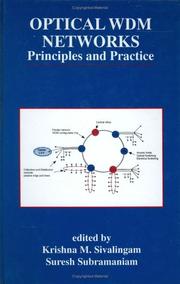
ISBN: 1280206209 9786610206209 0306470217 0792378253 Year: 2002 Publisher: New York, NY : Springer US : Imprint: Springer,
Abstract | Keywords | Export | Availability | Bookmark
 Loading...
Loading...Choose an application
- Reference Manager
- EndNote
- RefWorks (Direct export to RefWorks)
Optical WDM networking technology is spearheading a bandwidth revolution in the networking infrastructure being developed for the next generation Internet. Rapid advances in optical components have enabled the transition from point-to-point WDM links to all-optical networking. Optical WDM Networks: Principles and Practice presents some of the most important challenges facing the optical networking community, along with some suggested solutions. Earlier textbooks in optical networking have a narrower perspective, and rapidly advancing research has created the need for fresh and current information on problems and issues in the field. The volume editors and contributing authors have endeavoured to capture a substantial subset of the key problems and known solutions to these problems. All of the chapters are original contributions from leading international researchers. The chapters address a wide variety of topics, including the state of the art in WDM technology, physical components that make up WDM fiber-optic networks, medium access protocols, wavelength routed networks, optical access networks, network management, and performance evaluation of wavelength routing networks. The chapters also survey critical points in past research and tackle more recent problems. Practitioners and network product engineers interested in current state-of-the-art information beyond textbook-type coverage, and graduate students commencing research in this area, will appreciate the concise - and pertinent - information presented herein.
Optical communications. --- Multiplexing. --- Fiber optics. --- Routers (Computer networks) --- Computer Communication Networks. --- Telecommunication. --- Computer engineering. --- Surfaces (Physics). --- Communications Engineering, Networks. --- Electrical Engineering. --- Characterization and Evaluation of Materials. --- Computer communication systems. --- Electrical engineering. --- Materials science. --- Material science --- Physical sciences --- Electric engineering --- Engineering --- Communication systems, Computer --- Computer communication systems --- Data networks, Computer --- ECNs (Electronic communication networks) --- Electronic communication networks --- Networks, Computer --- Teleprocessing networks --- Data transmission systems --- Digital communications --- Electronic systems --- Information networks --- Telecommunication --- Cyberinfrastructure --- Electronic data processing --- Network computers --- Distributed processing --- Computer networks.
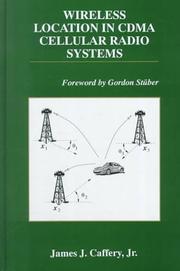
ISBN: 1280208090 9786610208098 0306473291 0792377036 Year: 2002 Publisher: New York : Kluwer Academic Publishers,
Abstract | Keywords | Export | Availability | Bookmark
 Loading...
Loading...Choose an application
- Reference Manager
- EndNote
- RefWorks (Direct export to RefWorks)
With the increasing market penetration of cellular telephones, the number of E-911 calls placed by cellular telephones has grown cons- erably. This growth in E-911 calls led to a 1996 FCC ruling requiring that all cellular, PCS, and SMR licensees provide location information for the support of E-911 safety services. The provision of such location information is to be implemented in two phases. Phase I, whose deadline has already been passed, requires that wireless carriers relay the caller’s telephone number along with location of the cell site and/or sector se- ing the call, to a designated Public Safety Answering Point (PSAP). This information allows the PSAP to return the call if disconnected. Phase II, to be completed by October 1, 2001, is much more stringent and requires that the location of an E-911 caller be determined and reported with an rms location accuracy of 125 m in 67% of the cases. The applications of wireless location technology extend well beyond E-911 services. Location information can be used by cellular telephone operators themselves for more effective management of their radio - sources, so as to achieve greater spectral efficiencies. Resource m- agement algorithms such as hand-offs between cell sites, channel assi- ments, and others can all benefit from subscriber location information. Location information obtained from vehicular based cellular telephones can be used as an input to Intelligent Transportation Systems (ITS), and in particular traffic management and traveler information systems.
Code division multiple access. --- Cell phone systems. --- Mobile communication systems. --- Automatic tracking. --- Computer engineering. --- Computer Communication Networks. --- Electrical Engineering. --- Electrical engineering. --- Computer communication systems. --- Communication systems, Computer --- Computer communication systems --- Data networks, Computer --- ECNs (Electronic communication networks) --- Electronic communication networks --- Networks, Computer --- Teleprocessing networks --- Data transmission systems --- Digital communications --- Electronic systems --- Information networks --- Telecommunication --- Cyberinfrastructure --- Electronic data processing --- Network computers --- Electric engineering --- Engineering --- Distributed processing
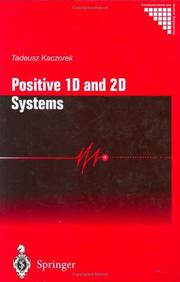
ISBN: 1852335084 9781852335083 1447110978 1447102215 Year: 2002 Publisher: London ; New York : Springer,
Abstract | Keywords | Export | Availability | Bookmark
 Loading...
Loading...Choose an application
- Reference Manager
- EndNote
- RefWorks (Direct export to RefWorks)
In the last decade a dynamic development in positive systems has been observed. Roughly speaking, positive systems are systems whose inputs, state variables and outputs take only nonnegative values. Examples of positive systems are industrial processes involving chemical reactors, heat exchangers and distillation columns, storage systems, compartmental systems, water and atmospheric pollution models. A variety of models having positive linear system behaviour can be found in engineering, management science, economics, social sciences, biology and medicine, etc. The basic mathematical tools for analysis and synthesis of linear systems are linear spaces and the theory of linear operators. Positive linear systems are defined on cones and not on linear spaces. This is why the theory of positive systems is more complicated and less advanced. The theory of positive systems has some elements in common with theories of linear and non-linear systems. Schematically the relationship between the theories of linear, non-linear and positive systems is shown in the following figure Figure 1.
Non-negative matrices --- Linear systems --- Matrices non négatives --- Systèmes linéaires --- Positive systems --- Matrices non négatives --- Systèmes linéaires --- Computer communication systems. --- Control engineering. --- System theory. --- Computer Communication Networks. --- Control and Systems Theory. --- Systems Theory, Control. --- Systems, Theory of --- Systems science --- Science --- Control engineering --- Control equipment --- Control theory --- Engineering instruments --- Automation --- Programmable controllers --- Communication systems, Computer --- Computer communication systems --- Data networks, Computer --- ECNs (Electronic communication networks) --- Electronic communication networks --- Networks, Computer --- Teleprocessing networks --- Data transmission systems --- Digital communications --- Electronic systems --- Information networks --- Telecommunication --- Cyberinfrastructure --- Electronic data processing --- Network computers --- Philosophy --- Distributed processing

ISBN: 3540456341 3540439625 Year: 2002 Publisher: Berlin, Heidelberg : Springer Berlin Heidelberg : Imprint: Springer,
Abstract | Keywords | Export | Availability | Bookmark
 Loading...
Loading...Choose an application
- Reference Manager
- EndNote
- RefWorks (Direct export to RefWorks)
This book presents revised full versions of papers contributed to UK Workshops on Multi-Agent Systems, UKMAS, during 1996 and 2000. From the early days of MAS research, the UK community has been a particularly productive one with numerous key contributions. The 15 papers by internationally reputed researchers deal with various aspects of agent technology, with a certain emphasis on foundational issues in multi-agent systems.
Intelligent agents (Computer software) --- Artificial intelligence --- Computer Science --- Engineering & Applied Sciences --- Computer science. --- Computer communication systems. --- Artificial intelligence. --- Computer Science. --- Artificial Intelligence (incl. Robotics). --- Computer Communication Networks. --- Artificial Intelligence. --- AI (Artificial intelligence) --- Artificial thinking --- Electronic brains --- Intellectronics --- Intelligence, Artificial --- Intelligent machines --- Machine intelligence --- Thinking, Artificial --- Bionics --- Cognitive science --- Digital computer simulation --- Electronic data processing --- Logic machines --- Machine theory --- Self-organizing systems --- Simulation methods --- Fifth generation computers --- Neural computers --- Communication systems, Computer --- Computer communication systems --- Data networks, Computer --- ECNs (Electronic communication networks) --- Electronic communication networks --- Networks, Computer --- Teleprocessing networks --- Data transmission systems --- Digital communications --- Electronic systems --- Information networks --- Telecommunication --- Cyberinfrastructure --- Network computers --- Distributed processing
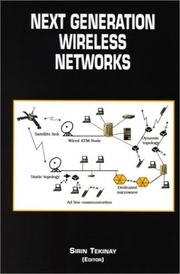
ISBN: 1280207930 9786610207930 0306473100 0792372409 Year: 2002 Publisher: New York, NY : Springer US : Imprint: Springer,
Abstract | Keywords | Export | Availability | Bookmark
 Loading...
Loading...Choose an application
- Reference Manager
- EndNote
- RefWorks (Direct export to RefWorks)
This book is a collection of extended versions of the papers presented at the Symposium on Next Generation Wireless Networks, May 26, 2000, New Jersey Institute of Technology, Newark, NJ. Each chapter includes, in addition to technical contributions, a tutorial of the corresponding area. It has been a privilege to bring together these contributions from researchers on the leading edge of the field. The papers were submitted in response to a call for papers aiming to concentrate on the applications and services for the “next generation,” deliberately omitting the numeric reference so that the authors’ vision of the future would not be limited by the definitive requirements of a particular set of standards. The book, as a result, reflects the top-down approach by focusing on enabling technologies for the applications and services that are the defining essentials for future wireless networks. This approach strikes a balance between the academia and the industry by addressing new wireless network architectures enabling mobility and location enhanced applications and services that will give wireless systems the competitive edge over others. The main theme of the book is the advent of wireless networks as an irreplaceable means of global communication as opposed to a mere substitute for, or a competitor of, wireline networks. Geolocation emerges as the facilitator of mobility and location sensitive services. The fields of geolocation and wireless communications have been forced to merge, following the Federal Commission of Communications’ (FCC) ruling that obliges wireless providers with emergency caller geolocation.
Wireless communication systems. --- Mobile communication systems. --- Global Positioning System. --- Computer engineering. --- Computer Communication Networks. --- Data structures (Computer scienc. --- Electrical Engineering. --- Data Structures and Information Theory. --- Electrical engineering. --- Computer communication systems. --- Data structures (Computer science). --- Information structures (Computer science) --- Structures, Data (Computer science) --- Structures, Information (Computer science) --- Electronic data processing --- File organization (Computer science) --- Abstract data types (Computer science) --- Communication systems, Computer --- Computer communication systems --- Data networks, Computer --- ECNs (Electronic communication networks) --- Electronic communication networks --- Networks, Computer --- Teleprocessing networks --- Data transmission systems --- Digital communications --- Electronic systems --- Information networks --- Telecommunication --- Cyberinfrastructure --- Network computers --- Electric engineering --- Engineering --- Distributed processing

ISBN: 0792378199 9786610207961 1280207965 0306473135 Year: 2002 Publisher: New York : Kluwer Academic Publishers,
Abstract | Keywords | Export | Availability | Bookmark
 Loading...
Loading...Choose an application
- Reference Manager
- EndNote
- RefWorks (Direct export to RefWorks)
Due to the explosive global growth in the number of mobile subscribers, as well as the growth predicted in the mobile data segment, the need for improved spectrum efficiency on the radio interface becomes more and more important. Frequency hopping (FH) is an effective method for improving the spectrum efficiency. One of the advantages of FH is that it can be combined with other spectral efficiency improving features like power control, handover and reuse partitioning. Performance Enhancements in a Frequency Hopping GSM Network covers FH and some of the additional features in detail. It begins with an in-depth description of the basic concept of FH on link level as well as on system level. Different methods have been used for analysis, such as link level simulations, network level simulations and classic tele-traffic theory. Special features of Performance Enhancements in a Frequency Hopping GSM Network: Combines the practical experiences of operator and vendor with more theoretical research methods. An in-depth treatment of prevailing problems in GSM networks; Presentation of a new method, computer-aided network design (CAND), which has been developed to analyse the complex network structures of a GSM network. CAND provides the possibility for more realistic performance evaluations than conventional methods; Provides GSM-specific analysis of functionality improvements in power control, discontinuous transmission, and several handover algorithms; Explanation of the quality and capacity gains of features like the combination of FH and reuse partitioning, referred to as intelligent frequency hopping; A frequency planning method for FH GSM networks is presented. This method exploits the benefits from FH directly in the allocation process, increasing the overall frequency plan.
Gsm's --- Electrical engineering. --- Data structures (Computer science). --- Computer communication systems. --- Electrical Engineering. --- Data Structures and Information Theory. --- Computer Communication Networks. --- Communication systems, Computer --- Computer communication systems --- Data networks, Computer --- ECNs (Electronic communication networks) --- Electronic communication networks --- Networks, Computer --- Teleprocessing networks --- Data transmission systems --- Digital communications --- Electronic systems --- Information networks --- Telecommunication --- Cyberinfrastructure --- Electronic data processing --- Network computers --- Information structures (Computer science) --- Structures, Data (Computer science) --- Structures, Information (Computer science) --- File organization (Computer science) --- Abstract data types (Computer science) --- Electric engineering --- Engineering --- Distributed processing --- Global system for mobile communications. --- GSM communications --- Cell phone systems --- Context-aware computing
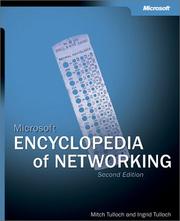
ISBN: 0735613788 Year: 2002 Publisher: Redmond Microsoft press
Abstract | Keywords | Export | Availability | Bookmark
 Loading...
Loading...Choose an application
- Reference Manager
- EndNote
- RefWorks (Direct export to RefWorks)
Computer networks --- netwerken --- encyclopedie --- terminologie --- 681.324 --- Computernetwerken (Netwerken informatica) --- Netwerktechnologie --- Communication systems, Computer --- Computer communication systems --- Data networks, Computer --- ECNs (Electronic communication networks) --- Electronic communication networks --- Networks, Computer --- Teleprocessing networks --- Data transmission systems --- Digital communications --- Electronic systems --- Information networks --- Telecommunication --- Cyberinfrastructure --- Electronic data processing --- Network computers --- Distributed processing
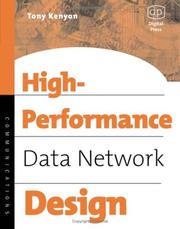
ISBN: 1281006971 9786611006976 0080491456 1555582079 0585457476 9780585457475 9781555582074 9780080491455 Year: 2002 Publisher: Boston : Digital Press,
Abstract | Keywords | Export | Availability | Bookmark
 Loading...
Loading...Choose an application
- Reference Manager
- EndNote
- RefWorks (Direct export to RefWorks)
High-Performance Data Network Design contains comprehensive coverage of network design, performance, and availability. Tony Kenyon provides the tools to solve medium- to large-scale data network design problems from the ground up. He lays out a practical and systematic approach that integrates network planning, research, design, and deployment, using state-of-the-art techniques in performance analysis, cost analysis, simulation, and topology modeling.The proliferation and complexity of data networks today is challenging our ability to design and manage them effectively. A new generatio
Computer networks. --- Computer network protocols. --- Computer networks --- Computer network architectures. --- Standards. --- Architectures, Computer network --- Network architectures, Computer --- Protocols, Computer network --- Communication systems, Computer --- Computer communication systems --- Data networks, Computer --- ECNs (Electronic communication networks) --- Electronic communication networks --- Networks, Computer --- Teleprocessing networks --- Computer architecture --- Data transmission systems --- Digital communications --- Electronic systems --- Information networks --- Telecommunication --- Cyberinfrastructure --- Electronic data processing --- Network computers --- Distributed processing
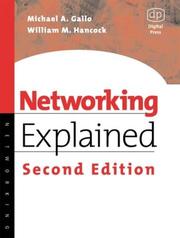
ISBN: 1281019828 9786611019822 0080512593 1435601068 1555582524 9781555582524 9781435601062 9781281019820 6611019820 9780080512594 Year: 2002 Publisher: Boston Digital Press
Abstract | Keywords | Export | Availability | Bookmark
 Loading...
Loading...Choose an application
- Reference Manager
- EndNote
- RefWorks (Direct export to RefWorks)
Networking Explained 2E offers a comprehensive overview of computer networking, with new chapters and sections to cover the latest developments in the field, including voice and data wireless networking, multimedia networking, and network convergence.Gallo and Hancock provide a sophisticated introduction to their subject in a clear, readable format. These two top networking experts answer hundreds of questions about hardware, software, standards, and future directions in network technology.Wireless networksConvergence of voice and dataMultimedia networking
Computer networks. --- Communication systems, Computer --- Computer communication systems --- Data networks, Computer --- ECNs (Electronic communication networks) --- Electronic communication networks --- Networks, Computer --- Teleprocessing networks --- Data transmission systems --- Digital communications --- Electronic systems --- Information networks --- Telecommunication --- Cyberinfrastructure --- Electronic data processing --- Network computers --- Distributed processing --- Information Technology --- General and Others
| Listing 1 - 10 of 117 | << page >> |
Sort by
|

 Search
Search Feedback
Feedback About UniCat
About UniCat  Help
Help News
News